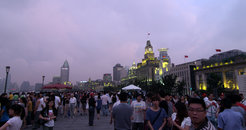Thoughts from Shanghai’s Bund
by Dan Smyer Yu
I’m in Shanghai again for fieldwork. For my first book I was here half a decade ago working on the irrational, fluid nature of money and religion (Buddhism) among urbanites in China. I returned with the same interest this summer but am developing more interest in “everyday religion” or “lived religion,” meaning that the practice of religion is not necessarily going along with canonic and doctrinal requirements and regimentations, but constantly negotiates with one’s everyday routines in the relational sense encompassing familial, professional, and social dimensions but grounded in the practicing person. The trend of serious religious practices is undoubtedly becoming more and more home-based and/or privately coordinated. It is not merely the state politics of religion at work. While working with home-based Buddhists I often take time to walk around temples, monasteries, and central locations of Shanghai and other cities in its vicinity. I could see what Adam Chau refers to as “Red Hot Sociality” at temples, monasteries, and downtowns, but its “religiosity” is most definitely more economic and entertainment-related than religious. China is undoubtedly a global site of the “Red Hot Sociality” with 10% growth and a never-ending stream of breaking news on a variety of human affairs. Practitioners of world religions like Christianity and Buddhism in urban China continue to seek physical spaces for membership-based communal gathering and thought-sharing. Public sphere of urban China is not as tolerable to religious practices as in other countries. What’s “hot” in the public space is not necessarily acceptable to religion. For the last couple of weeks I have done a bit of “thermal testing” on the “hot” sites of Shanghai. By “hot” I mean the onsite density of people; sights that unceasingly draw visual and audio attentions from people; the high consumption of energy (fuel and electricity); and the ambient space itself which contains imaginative, symbolic, or monumental architectures and landmarks. The city has to give itself a distinction.
I thought I share a few photos I took with my readers about what I see as the “hot” places of Shanghai:

The Bund or Waitan is the gravitational center of Shanghai. Locals, tourists, foreign residents like flocking there. Many locals are particularly drawn to it when the sun is setting, neon lights come on, and cool breezes come in from Huangpu River. The well-lit colonial architecture left behind by the British and French are part and parcel of Shanghai’s identity. It is the hottest place of the city in the hours of 6:00pm to 11:00pm.

In the midst of the crowd I hear dialects of all sorts as well as English, German, French, Russian, and Spanish. Nearly everyone I see has a digital camera. My camera is bulky for landscape photography but rarely attracts attention from people around me except a few young men in the uniform marked “Ground Security,” who made sure that I would not interview anybody. I turn 360 degree. It is truly a “hot sociality” of people but they do not come here with a single common purpose. The place is “hot” with people, colonial architectures, and neon lights but is cool with breezes from the East China Sea. The colonial architectures surely embed memory, history, and nostalgia. In the meantime the river flows out into the Pacific with a sense of openness, longing, and aspiration.

When the night falls, thousands of eyes look toward Pudong on the other shore. The Pearl Tower looks tilted. It is because of my panoramic lens slightly distorts the scene. Children are pointing at the passing boats and many adults are reading the commercial signs of China Mobile, Wuliang Liquor, Aurora, and other brand name companies. They are “shanghai’ed” with the mesmerizing ambience.

Things modern have been enchanting the Chinese over a century now. Mastering of modern science and technology has been the national priority of both Republic and People’s Republic of Chinas. But, becoming modern or being modern outside the West seems to have a bit of time lapse – a sense of lagging behind and moving forward parallel with one another, in which the temporal and value distances consistently set the West and the Rest apart. If Chairman Mao’s Great Leap Forward of the 1950s intended to catch up with the West failed the hopes and dreams of his billion subjects with famines, what is the current great leap forward of economic development and globalization bringing to urbanites of China? At the Bund, most people’s visions go up: they are “touching” the tips of the Pearl Tower and are being drawn into the ambient lights of the night sky and the city-lights. Bumping into each other and stepping on each other’s toes are commonplace, but their eyes cannot help but look up. Like other rapidly developing cities of China, the height of architectures is often an indicator of the height and intensity of dreams, hopes, and imaginations for a better future, however one defines it.

The presence of the past is a distinct character of Shanghai’s Bund. The colonial era was long gone but its architectures are now being re-appropriated and regarded as Shanghai’s global connectivity. The agony of “Old Shanghai” has receded into the deeper layer of the city’s memory. It is being turned into a New Shanghai, a global bull market, real or projected. The invisible, diagonal line in the photo separates the well-lit former British Concession and the Bund in the dark, but constant flows of people getting off buses, taxis, and walking out of their hotels are crossing the line of the light and the dark, up to the Bund.
















